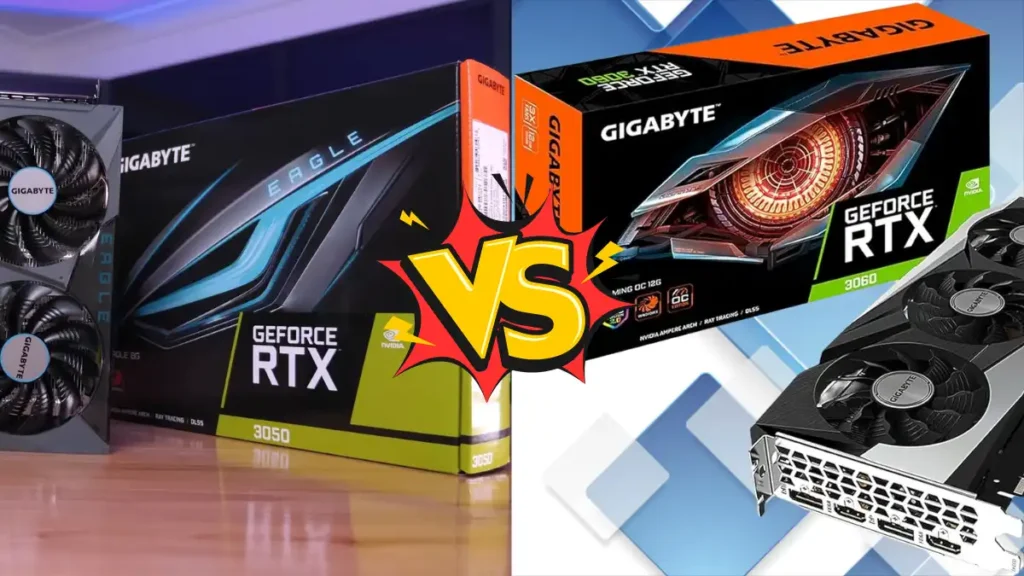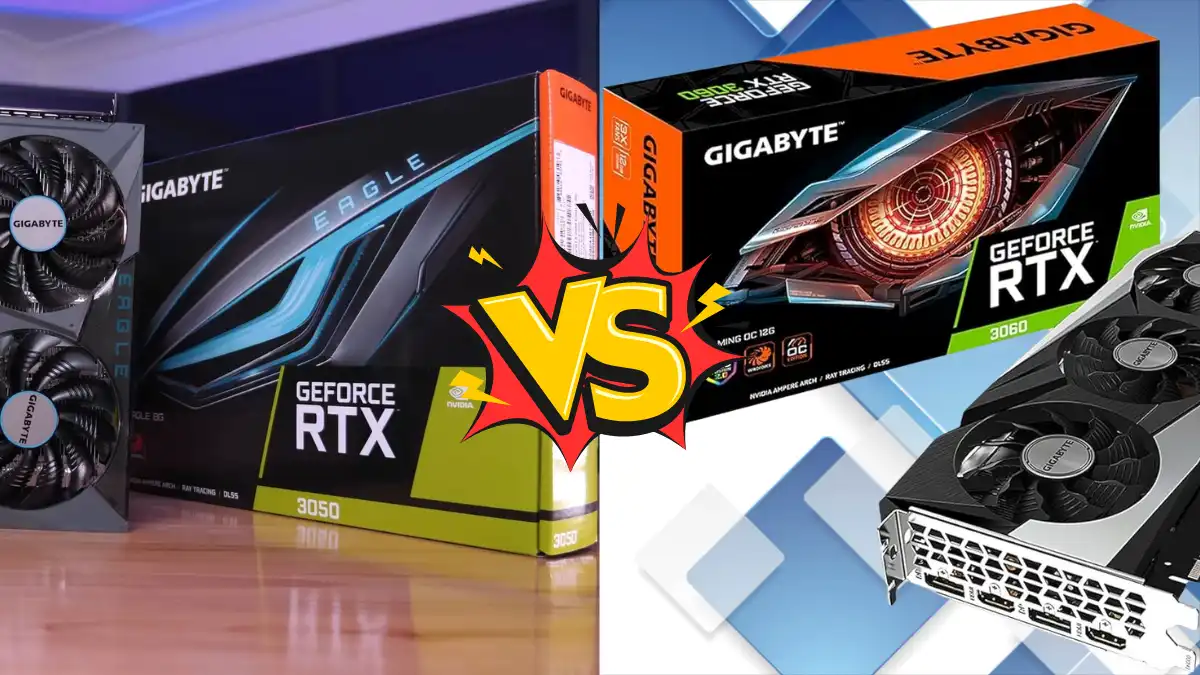Nvidia RTX 3050 6GB vs Nvidia RTX 3060: Nvidia’s recent unveiling of the GeForce RTX 3050 6GB, hitting stores on February 2, 2024, has stirred excitement among PC enthusiasts. This mid-range graphics card, constructed on the 8 nm process and centered around the GA107 graphics processor (specifically the GA107-325-A1 variant), promises notable capabilities. Notably, it boasts DirectX 12 Ultimate support, guaranteeing seamless integration with contemporary gaming titles.

As the RTX 3050 emerges into the scene, questions naturally arise regarding its performance relative to other Nvidia GeForce GPUs, especially the RTX 3060. This sparks a compelling comparison, prompting a closer look at the intricate details and capabilities of both graphics cards. Join us as we delve into the nuances of the Nvidia RTX 3050 6GB versus RTX 3060, exploring their features, specifications, and potential performance differentials to provide insights for PC enthusiasts and gamers alike.
Nvidia RTX 3050 6GB vs Nvidia RTX 3060 : Specs
Let’s delve into the specs and components of the RTX 3050 6GB and RTX 3060. Both feature the 8nm Ampere architecture, signaling improved efficiency and performance. Notably, the RTX 3060’s larger processor size of 12,000 million transistors, compared to the RTX 3050’s 8,700 million, hints at potential advantages in processing power and efficiency.
| Specification | RTX 3050 (6GB) | RTX 3060 |
|---|---|---|
| Graphics Processing Unit | NVIDIA® RTX 3050 | NVIDIA® RTX 3060 |
| Memory Size | 6GB | 12GB |
| Memory Type | GDDR6 | GDDR6 |
| Memory Bus | 128-bit | 192-bit |
| CUDA® Cores | – | 3584 |
| Core Clocks | 1042 MHz (Base) | Boost: 1837 MHz |
| Memory Speed | 14 Gbps | 15 Gbps |
| TDP (Watt) | 70 W | 170 W |
| Power Connectors | 8-pin x 1 | 8-pin x 1 / 6-pin x 1 |
| Recommended PSU | 550 W | 550 W |
| DirectX Version Support | 12 API | 12 API |
| OpenGL Version Support | 4.6 | 4.6 |
| Maximum Displays | 4 | 4 |
| Digital Maximum Resolution | 7680×4320 | 7680×4320 |
| Architecture | Ampere | Ampere |
| Processor Size | 8 nm | 8 nm |
| Transistors | 8,700 million | 12,000 million |
| Base Clock Speed | 1042 MHz | 1320 MHz |
| Max Boost Clock Speed | 1470 MHz | 1777 MHz |
| L1 Cache | 128 KB (per SM) | 128 KB (per SM) |
| L2 Cache | 2 MB | 3 MB |
The Nvidia GeForce RTX 3060 surpasses the RTX 3050 in performance, showcasing higher base and boost clocks. The RTX 3060 operates at a base clock of 1320 MHz and a boost clock of 1777 MHz, while the RTX 3050 6GB falls behind with a base clock of 1042 MHz and a boost clock of 1470 MHz. These disparities in clock speeds directly influence the overall performance and responsiveness of the GPUs, especially during resource-intensive gaming or rendering tasks.
In addition to superior clock speeds, the RTX 3060 doubles the memory size of the RTX 3050, offering 12GB of VRAM compared to the RTX 3050’s 6GB. Furthermore, the RTX 3060 features a broader memory bus (192-bit) and higher memory clock speeds, resulting in significantly increased memory bandwidth (360.0 GB/s) compared to the RTX 3050’s more modest bandwidth (168.0 GB/s). These improvements empower the RTX 3060 to effortlessly handle larger textures and more intricate scenes, establishing it as the preferred choice for high-resolution gaming and content creation.
Moreover, core counts, including cuda, ray tracing, and tensor cores, play a crucial role in determining GPU performance and rendering capabilities. The RTX 3060 boasts higher core and shading unit counts than the RTX 3050, delivering superior rendering and graphical processing capabilities. With 3584 shading units and 28 cores per streaming multiprocessor (SM), the RTX 3060 can manage more intricate shaders and lighting effects, leading to smoother and more immersive gaming experiences on your device.
Despite these performance advantages, it’s vital to take into account factors such as power consumption and pricing when assessing GPU options. The RTX 3050 features a significantly lower thermal design power (TDP) of 70W compared to the RTX 3060’s 170W TDP, making it a more power-efficient choice for budget-conscious consumers. Additionally, with a lower price point of $179, the RTX 3050 becomes an appealing option for gamers on a tight budget.
Nvidia RTX 3050 6GB vs Nvidia RTX 3060: Performance Comparison
In most gaming and performance benchmarks, the RTX 3060 typically outperforms the RTX 3050 by approximately 15-20%. In terms of gaming, at 1080p resolution, both GPUs handle modern games well, but the RTX 3060 often achieves higher frame rates, particularly in demanding titles. For 1440p gaming, the RTX 3060 provides smoother performance at high settings, while the RTX 3050 may struggle with some titles, especially with ray tracing enabled. Neither GPU is ideal for 4K gaming at high settings, although the RTX 3060 might manage older or less demanding games at 4K with lower settings.
In other performance aspects, both GPUs support ray tracing, but the RTX 3060’s more dedicated ray tracing cores (80 vs 20) result in better performance and smoother visuals. The RTX 3060’s higher memory capacity (12GB vs 6GB) makes it better suited for content creation tasks like video editing and 3D rendering, which involve handling large datasets.
Considering additional factors, the RTX 3050 is significantly cheaper than the RTX 3060, making it a more budget-friendly option. Moreover, the RTX 3050 consumes less power, potentially saving on electricity costs and requiring a less powerful power supply.
In summary, for casual gamers on a tight budget primarily playing at 1080p, the RTX 3050 is a decent choice. For demanding gamers seeking higher resolutions, smoother frame rates, better ray tracing performance, or using the GPU for content creation, the RTX 3060 is the superior option. It’s important to note that these are general comparisons, and specific performance can vary based on the game, settings, and other system components. Checking independent benchmarks and reviews for specific titles and tasks is recommended.
Nvidia RTX 3050 6GB vs Nvidia RTX 3060 : Price and Value
The trade-off between these two GPUs boils down to budget and priorities. Here’s a breakdown:
Price:
- RTX 3050 6GB: Significantly cheaper, with an MSRP of $179 (although current market prices might be higher).
- RTX 3060: More expensive, with an MSRP of $329 (again, current market prices might vary).
Value:
- RTX 3050 6GB: Offers better value for budget-conscious gamers playing at 1080p resolution who prioritize affordability over high-end performance.
- RTX 3060: Provides better value for performance-oriented gamers who want higher frame rates, smoother gameplay at 1440p or higher, and better ray tracing capabilities. It also benefits content creators with its higher VRAM capacity.
| Feature | RTX 3050 6GB | RTX 3060 |
|---|---|---|
| Price (MSRP) | $179 | $329 |
| Value for: | Budget gamers at 1080p | Performance-oriented gamers, content creators |
| Strengths: | More affordable, lower power consumption | Higher performance, more VRAM, better ray tracing |
| Weaknesses: | Lower performance, less VRAM | More expensive, higher power consumption |
Ultimately, the best value depends on your individual needs and budget. If affordability is your top priority and you’re content with 1080p gaming, the RTX 3050 offers good value. But if you want smoother performance, higher resolutions, or use the GPU for demanding tasks, the RTX 3060 is worth the extra cost.
Is the Nvidia RTX 3050 6GB suitable for gaming?
Yes, the Nvidia RTX 3050 6GB is suitable for gaming, especially for casual gamers who play at 1080p resolution. It can handle most modern games at playable frame rates with medium to high graphics settings. However, it’s not the best choice for demanding gamers who want to play at higher resolutions or with all the bells and whistles turned on.
- 1080p resolution: The RTX 3050 can handle most modern games at 1080p with high frame rates and good visual quality. You can expect to get 60+ FPS in most titles with medium to high settings.
- 1440p resolution: The RTX 3050 can handle some games at 1440p resolution, but you may need to lower the graphics settings to maintain smooth frame rates. Expect around 30-45 FPS in demanding titles at medium settings.
- 4K resolution: The RTX 3050 is not ideal for 4K gaming. You may be able to play some older titles or less demanding games at 4K with low settings, but the experience won’t be very smooth.
- Your budget: The RTX 3050 is a relatively affordable graphics card, making it a good option for budget-conscious gamers.
- The games you play: If you mostly play older games or less demanding titles, the RTX 3050 will be sufficient. However, if you play the latest and greatest games at high settings, you’ll likely want a more powerful GPU.
- Your preferred resolution: If you’re happy gaming at 1080p, the RTX 3050 is a good choice. However, if you want to play at 1440p or higher, you’ll need a more powerful GPU.
Overall, the Nvidia RTX 3050 6GB is a decent graphics card for casual gamers who play at 1080p resolution. However, if you’re a demanding gamer who wants to play at higher resolutions or with all the bells and whistles turned on, you’ll need a more powerful GPU.
Conclusion
Both the Nvidia RTX 3050 6GB and RTX 3060 are good choices, but they have key differences to suit different needs. The RTX 3060 is better for gamers and content creators who want top-notch performance and graphics, thanks to its higher power and memory capacity. On the other hand, the RTX 3050 is more budget-friendly and power-efficient, making it a good option for gamers looking for solid 1080p performance without spending too much.
VISIT HOMEPAGE FOR LATEST INFORMATION
